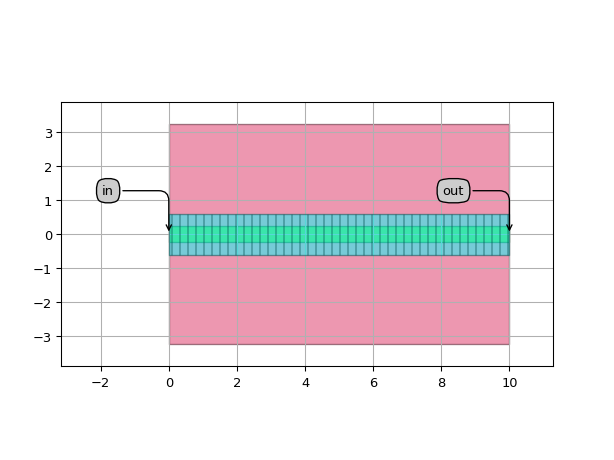ThinnedWaveguideTemplate
- class picazzo3.traces.thin_wg.ThinnedWaveguideTemplate
Thinned waveguide.
Takes an existing waveguide template (given by trace_template) and overlay with a thinning layer.
- Parameters:
- trace_template: PCell and _TraceTemplate
Refers to the other trace template from which information is taken to build this trace template.
- name: String that contains only ISO/IEC 8859-1 (extended ASCII py3) or pure ASCII (py2) characters
The unique name of the pcell
Views
- class Layout
- Parameters:
- thin_width: float and Real, number and number >= 0
width of the thinning layer
- thin_purpose: PatternPurpose
drawing purpose for the thinning region
- thin_process: ProcessLayer
thinning process
- cladding_process: ProcessLayer
process for the waveguide cladding, defaults to the core process
- core_purpose: PatternPurpose
drawing purpose for the waveguide core
- core_process: ProcessLayer
process for the waveguide core
- cladding_width: float and number > 0
total width of the waveguide with cladding
- cladding_purpose: PatternPurpose
drawing purpose layer for the cladding
- core_width: float and number > 0
width of the waveguide core
- core_layer: __Layer__
layer used to define the core of the waveguide
- flatten_contents: ( bool, bool_ or int )
if True, it will insert the referred trace as elements in the layout, rather than as an Instance
- pin_shape: Shape
shape to be used for the pins
- trace_template_for_ports: _TraceTemplate.Layout
Trace template to be used for the ports. Default = this template
- windows: List with type restriction, allowed types: <class ‘ipkiss3.pcell.trace.window.window._TraceWindow’>
List of Trace Windows that know how to draw themselves relative to the shape of the Trace
- keep_original_trace_template: ( bool, bool_ or int )
- width: float and Real, number and number >= 0
- control_shape_layer: __Layer__
layer on which the control shape is drawn
- draw_control_shape: ( bool, bool_ or int )
draws the control shape on top of the waveguide
- cover_layers: List with type restriction, allowed types: <class ‘ipkiss.primitives.layer.Layer’>
layers that can be used to generate additional coverage of the trace (e.g. manhattan corners)
- view_name: String that contains only alphanumeric characters from the ASCII set or contains _$. ASCII set is extended on PY3.
The name of the view
Examples
"""This example shows how you use the template to directly create a thinned waveguide PCell and its layout. """ import si_fab.all as pdk # noqa: F401 from ipkiss3 import all as i3 from picazzo3.traces.wire_wg.trace import WireWaveguideTemplate from picazzo3.traces.thin_wg.trace import ThinnedWaveguideTemplate wg_t = WireWaveguideTemplate(name="my_wire_wg_template1") wg_t.Layout(core_width=0.47, cladding_width=2 * 3.0 + 0.47, core_process=i3.TECH.PROCESS.WG) thinwg_t = ThinnedWaveguideTemplate(trace_template=wg_t, name="my_thin_wg_template1") thinwg_t.Layout(thin_process=i3.TECH.PROCESS.FC, thin_width=1.2) wg = thinwg_t(name="my_thin_waveguide1") layout = wg.Layout(shape=[(0.0, 0.0), (10.0, 0.0)]) layout.visualize(annotate=True)
